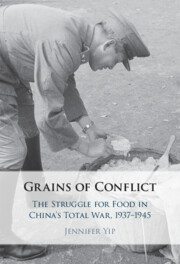Refine search
Actions for selected content:
15366 results in Military history
Dramatis Personae
-
- Book:
- The Wars of the Roses
- Published online:
- 24 July 2025
- Print publication:
- 04 September 2025, pp 212-252
-
- Chapter
- Export citation
Conclusion
-
- Book:
- The Wars of the Roses
- Published online:
- 24 July 2025
- Print publication:
- 04 September 2025, pp 202-211
-
- Chapter
- Export citation
Note on the Text
-
- Book:
- The Wars of the Roses
- Published online:
- 24 July 2025
- Print publication:
- 04 September 2025, pp xi-xi
-
- Chapter
- Export citation
1 - The Civil Wars We Think We Know: Narrativity and Politics
-
- Book:
- The Wars of the Roses
- Published online:
- 24 July 2025
- Print publication:
- 04 September 2025, pp 30-63
-
- Chapter
- Export citation
Contents
-
- Book:
- The Wars of the Roses
- Published online:
- 24 July 2025
- Print publication:
- 04 September 2025, pp vii-vii
-
- Chapter
- Export citation
Abbreviations
-
- Book:
- The Wars of the Roses
- Published online:
- 24 July 2025
- Print publication:
- 04 September 2025, pp xii-xv
-
- Chapter
- Export citation
Maps
-
- Book:
- The Wars of the Roses
- Published online:
- 24 July 2025
- Print publication:
- 04 September 2025, pp xvi-xvii
-
- Chapter
- Export citation
4 - Political Economy and Civil Conflict
-
- Book:
- The Wars of the Roses
- Published online:
- 24 July 2025
- Print publication:
- 04 September 2025, pp 126-166
-
- Chapter
- Export citation
Introduction
-
- Book:
- The Wars of the Roses
- Published online:
- 24 July 2025
- Print publication:
- 04 September 2025, pp 1-29
-
- Chapter
- Export citation
3 - Logics of Political Division
-
- Book:
- The Wars of the Roses
- Published online:
- 24 July 2025
- Print publication:
- 04 September 2025, pp 92-125
-
- Chapter
- Export citation
Bibliography
-
- Book:
- The Wars of the Roses
- Published online:
- 24 July 2025
- Print publication:
- 04 September 2025, pp 266-295
-
- Chapter
- Export citation
2 - Reform and the Common Weal
-
- Book:
- The Wars of the Roses
- Published online:
- 24 July 2025
- Print publication:
- 04 September 2025, pp 64-91
-
- Chapter
- Export citation
Acknowledgements
-
- Book:
- The Wars of the Roses
- Published online:
- 24 July 2025
- Print publication:
- 04 September 2025, pp viii-x
-
- Chapter
- Export citation
5 - Geographies of Contention
-
- Book:
- The Wars of the Roses
- Published online:
- 24 July 2025
- Print publication:
- 04 September 2025, pp 167-201
-
- Chapter
- Export citation

Grains of Conflict
- The Struggle for Food in China's Total War, 1937–1945
-
- Published online:
- 23 August 2025
- Print publication:
- 31 July 2025
6 - Conclusion
-
- Book:
- The Colonial Way of War
- Published online:
- 04 September 2025
- Print publication:
- 21 August 2025, pp 306-314
-
- Chapter
- Export citation
Acknowledgements
-
- Book:
- The Colonial Way of War
- Published online:
- 04 September 2025
- Print publication:
- 21 August 2025, pp viii-x
-
- Chapter
- Export citation
5 - Practices of Violence
-
- Book:
- The Colonial Way of War
- Published online:
- 04 September 2025
- Print publication:
- 21 August 2025, pp 239-305
-
- Chapter
- Export citation
4 - Knowledge Transfers
-
- Book:
- The Colonial Way of War
- Published online:
- 04 September 2025
- Print publication:
- 21 August 2025, pp 188-238
-
- Chapter
- Export citation
Introduction
-
- Book:
- The Colonial Way of War
- Published online:
- 04 September 2025
- Print publication:
- 21 August 2025, pp 1-37
-
- Chapter
- Export citation
